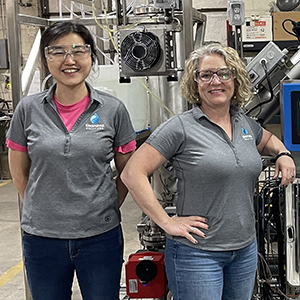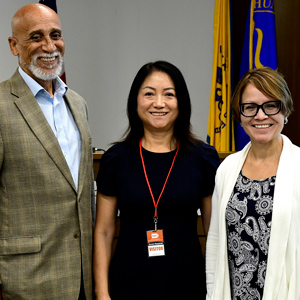New Hampshire Governor Chris Sununu signed a bill July 12 that sharply lowers the state’s drinking water limit for arsenic. The new rule, informed by research and outreach efforts from NIEHS grantees at the Dartmouth College Superfund Research Program (SRP) Center, cuts the state standard in half — from the federal level of 10 parts per billion (ppb) to 5 ppb.
“Dartmouth SRP research has indicated human health effects of arsenic at levels above 5 ppb,” said Center Director Celia Chen, Ph.D. “Here in New Hampshire, decision-makers have used that information to take steps that will make a difference for public health. Hopefully, this change will encourage other states to look more closely at arsenic.”
 Chen, left, and Laurie Reynolds Rardin, right, the center’s research translation coordinator, lead efforts to share research with government agencies, decision-makers, and community groups. (Photo courtesy of Eli Burakian, Dartmouth College)
Chen, left, and Laurie Reynolds Rardin, right, the center’s research translation coordinator, lead efforts to share research with government agencies, decision-makers, and community groups. (Photo courtesy of Eli Burakian, Dartmouth College)“The SRP has been at the forefront of funding research on arsenic for the last 30 years,” said SRP Director William Suk, Ph.D. “Transdisciplinary teams from SRP centers across the country have made important discoveries about how exposure to arsenic affects human health. We’re excited to see states using this important research to make decisions that better protect the health of their citizens.”
Ripple effect of health protections
The law applies to public water systems, yet nearly half of New Hampshire residents rely on private wells. The Dartmouth team hopes the change will lead to more voluntary testing and treatment, so they are working extensively with private well owners in northern New England to help them understand and address health risks.
For example, their comprehensive website, Arsenic and You, explains how people are exposed to arsenic and how they can prevent or reduce their exposures. The Community Engagement Core and the Research Translation Core also developed the Well Water Community Action Toolkit, which provides a step-by-step guide to help communities ensure the safety of private well water, and an informational video (see sidebar).
Informing policy takes time
According to Chen, collaborative partnerships were vital to the success of this new rule, especially the New Hampshire Arsenic Consortium, led by the Dartmouth SRP Center, which connects government, the water industry, and community members, including the following groups.
- New Hampshire Department of Environmental Services (NHDES).
- New Hampshire Department of Health and Human Services.
- U.S. Environmental Protection Agency.
- U.S. Geological Survey.
- State and local government officials.
“Our longstanding, trusted partnerships allow us to use our collective expertise to communicate our science, educate New Hampshire residents, and connect with diverse stakeholder groups,” said Rardin. “The consortium empowers its members to participate in lowering arsenic exposure rates in the state by developing consistent messaging and identifying more effective ways to tackle the challenges inherent with creating behavior change to reduce arsenic exposure.”
Based on both mounting evidence of arsenic’s health effects and efforts of the Arsenic Consortium, the New Hampshire legislature directed NHDES to review the arsenic rule in June 2018.
In December 2018, NHDES recommended a more protective limit in a report rooted in research by the SRP Center and the NIEHS-funded Dartmouth Children's Environmental Health and Disease Prevention Research Center. The report also cited findings on the impacts of arsenic on children’s IQ from Columbia University SRP Center.
“Reducing the arsenic MCL [maximum contaminant level] is consistent with the decades of research from Dartmouth and others linking arsenic to negative health effects,” said Chen. “Our team is proud to have played a leading role in helping the state make this decision to protect the health of people throughout New Hampshire.”
(Adeline Lopez is a research and communication specialist for MDB Inc., a contractor for the NIEHS Superfund Research Program.)









